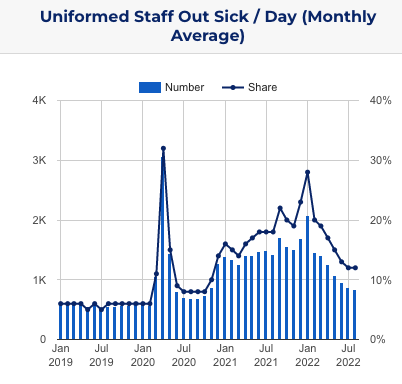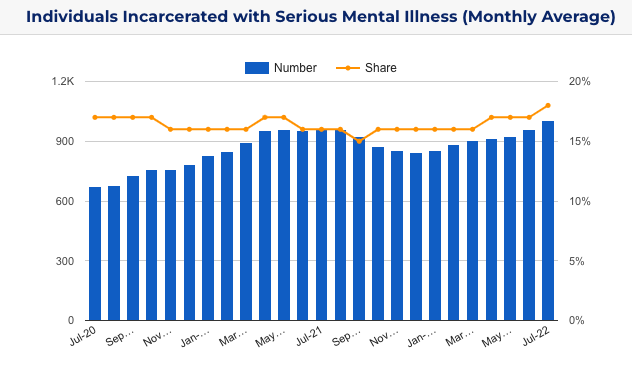Testimony of New York City Comptroller Brad Lander to the Board of Correction
Thank you to the members and staff of the Board of Correction for providing the opportunity to testify to you today, and for your ongoing work to demand accountability of the NYC Department of Correction.
Tarz Youngblood. George Pagan. Herman Diaz. Dashawn Carter. Mary Yehudah. Emanuel Sullivan. Antonio Bradley. Anibal Carrasquillo. Albert Drye. Elijah Muhammad. Michael Lopez. Ricardo Cruciani. Michael Nieves.
Thirteen lives taken in our City jails in just eight months this year – that makes 29 people since the beginning of 2021. And as the report that the Board released yesterday revealed, in at least 10 of the 16 deaths last year, there was some type of Correction officer lapse or failure.
As I appear before you today, to share my perspective on the ongoing crisis in our jails two weeks after visiting several of the facilities on Rikers Island myself, I fear that we are becoming accustomed to such loss – this ultimate form of violence. To be clear, the status quo is horrific and wholly unacceptable.
And yet the number of people in Department of Correction custody is rising. Yesterday, there were nearly 5,900 people in DOC custody – up 9% from the beginning of January. Length of stay in custody is similarly increasing; during the month of August, people discharged from City jails had spent an average of 114 days in custody, compared to 105 days in July. And unlike during the early days of the pandemic, the City does not appear to be taking any meaningful steps to decarcerate. In fact, year-to-date arrests are up 26%. The City-sentenced population, which had been reduced to around 100 during the pandemic and had largely stayed there, has now climbed to over 400 – up 186% since the start of this year.
With my testimony today, I would like to focus on two topics in particular: (1) the need for, and my own commitment to, greater transparency around DOC operations, particularly as the City works to implement its Action Plan, and (2) the urgency of ending all forms of solitary confinement.
DOC Dashboard
When I became Comptroller, I publicly pledged to do my part to hold the Department of Correction accountable for reducing violence and meeting minimum standards, and to bring some measure of public transparency to what have historically been opaque operations.
After making a request for information to the Department in January and analyzing data made available to us in subsequent months, my office released a DOC Dashboard that will offer to the public a regular accounting of key metrics related to staffing, population trends, violence, and service provision.
Later today, my office will be publishing our first monthly update, which shows that the share of officers out sick – a major factor in the ongoing staffing management crisis – which had seen reductions earlier this year, flattened out over the summer. In August, an average of 12% of uniformed officers were out sick each day, double the share of officers out sick in August 2019, prior to the pandemic.

With this month’s release, we are also adding a new chart to track the number and share of people in custody with serious mental illness, including schizophrenia, depression, and PTSD. According to the latest Local Law 59 reports from Correctional Health Services, more than 1,000 people, nearly one in five people in our City jails, has been diagnosed with serious mental illness.
We know they have little chance of getting adequate treatment in jail. We know that jail conditions are likely to make their illness worse. We know how quickly people can decompensate while in custody. The report the Board released yesterday on 10 of the 16 deaths in 2021 shows plainly the horrifying consequences of mental health conditions going untreated combined with the Department’s inability to render appropriate aid. Yet we continue to allow it to be the case that Rikers is the largest de facto mental health facility in the city.

We will continue to monitor and update these data – all of which can be easily downloaded from our website – in the coming months. It is my hope that this information will be useful to the public and to criminal legal system partners alike.
Ending Solitary Confinement
On August 29, I visited Rikers Island with Public Advocate Jumaane Williams and Council Member and Chair of the Committee on Criminal Justice Carlina Rivera, spending several hours touring four facilities: GRVC, EMTC, RMSC, and NIC. Given the delays in implementation of RMAS, one of my goals was to talk to some individuals detained in and staffing restrictive housing. The people I spoke to in GRVC reported that they were receiving 7 to 10 hours of out-of-cell time, and the conditions we observed were meaningfully better than the restricted housing units I have seen on prior visits.
However, we also saw first-hand that other forms of segregation being deployed by the Department are functioning as solitary confinement. . While touring NIC, I observed seven individuals in “protective custody” who were being held in dark, double-vestibule cells not much larger than their beds, for 22 or 23 hours a day, with no access to meaningful engagement with other people or to congregate programming, without any deadline, well beyond 15 consecutive days, for weeks on end. DOC’s claim that going from one dark, tiny vestibule to the other, neither large enough to fit the desk I’m sitting at, counts as “out of cell” time is, frankly, gaslighting.
We also know that Elijah Muhammad died in July after being locked in one of the Department’s so-called de-escalation units.
This cannot continue. I am encouraged that the City Council will soon be considering legislation to more strongly prohibit solitary confinement by DOC. I’m eager to make sure it would clearly and firmly prohibit the solitary confinement I saw recently.
During our visit, I also asked about how DOC had improved their suicide watch protocols, given recent suicides. I was assured by the DOC staff I spoke with that they had taken steps to improve and had things under control. Infuriatingly, we were not told that just days earlier Michael Nieves had attempted suicide with Correction officers watching and failing to intervene – he was on life support as we were touring and died the following day.
I know that there are staff on Rikers Island today who are working in good faith to improve conditions. We met some of them on our visit. But the reality we must face is that the deaths and violence have not abated. While I recognize that the jail population is the result of decision making on the part of many different criminal legal system actors, the Board of Correction is a critical voice. With the data before you now – on deaths, on persistent staff absenteeism, and rates of violence – I urge you to support and call publicly for immediate reductions in the jail population; to ensure no person who is placed in the custody of DOC for any length of time is ever held again in solitary confinement; and to establish firm expectations for improvements in the rates of violence and death, with consequences up to and including the Board’s support for receivership if they are not met.
Thank you.
###